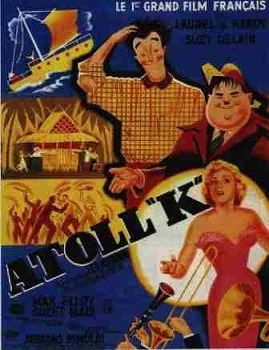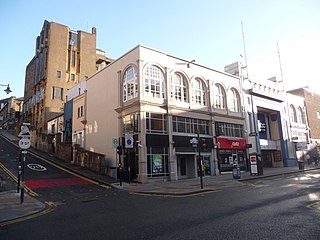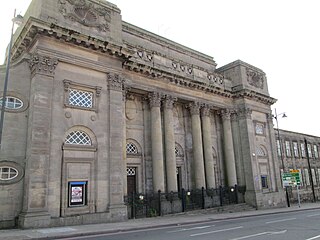
Stan Laurel was an English comic actor, writer, and film director who was one half of the comedy duo Laurel and Hardy. He appeared with his comedy partner Oliver Hardy in 107 short films, feature films, and cameo roles.

Pollokshields is an area in the Southside of Glasgow, Scotland. Its modern boundaries are largely man-made, being formed by the M77 motorway to the west and northwest with the open land of Pollok Country Park and the Dumbreck neighbourhood beyond, by the Inverclyde Line railway and other branches which separate its territory from the largely industrial areas of Kinning Park, Kingston and Port Eglinton, and by the Glasgow South Western Line running from the east to south, bordering Govanhill, Strathbungo, Crossmyloof and Shawlands residential areas. There is also a suburban railway running through the area.

The Criterion Theatre is a West End theatre at Piccadilly Circus in the City of Westminster, and is a Grade II* listed building. It has a seating capacity of 588.

Way Out West is a 1937 Laurel and Hardy comedy film directed by James W. Horne, produced by Stan Laurel, and distributed by Metro-Goldwyn-Mayer. It was the second picture for which Stan Laurel was credited as producer.

Public Auditorium is a multi-purpose performing arts, entertainment, sports, and exposition facility located in the civic center district of downtown Cleveland, Ohio. The 10,000-capacity main auditorium shares its stage with a second venue housed at the facility: the 3,000-capacity Music Hall. Although Public Auditorium was planned and funded prior to World War I, construction did not begin until 1920, and the building did not open until 1922. Designed by city architect J. Harold McDowell and Frank Walker of Walker and Weeks in a neoclassical style matching the other Group Plan buildings, it was the largest of its kind when opened, then seating 11,500.

Atoll K is a 1951 Franco-Italian co-production film—also known as Robinson Crusoeland in the United Kingdom and Utopia in the United States – which starred the comedy duo Laurel and Hardy in their final screen appearance. The film co-stars French singer/actress Suzy Delair and was directed by Léo Joannon, with uncredited co-direction by blacklisted U.S. director John Berry.

The Theatre Royal is the oldest theatre in Glasgow and the longest running in Scotland. Located at 282 Hope Street, its front door was originally round the corner in Cowcaddens Street. It currently accommodates 1,541 people and is owned by Scottish Opera. The theatre opened in 1867, adopting the name Theatre Royal two years later. It is also the birthplace of Howard & Wyndham Ltd, owners and managers of theatres in Scotland and England until the 1970s, created by its chairman Baillie Michael Simons in 1895. It was Simons who as a cultural entrepreneur of his day also promoted the building of Kelvingrove Art Gallery and Museum and Glasgow's International Exhibitions of 1888 and 1901.

His Majesty's Theatre is an Edwardian Baroque theatre in Perth, Western Australia. Constructed from 1902 to 1904 during a period of great growth for the town, the theatre is located on the corner of Hay Street and King Street in Perth's central business district.

The Maryland Theatre is a music and entertainment venue located in the Arts and Entertainment District of downtown Hagerstown, Maryland. It was built in 1915, partially destroyed by fire in 1974, reopened in 1978, and expanded into a full performing arts complex in 2019. The theatre's seating capacity is 1,279 people, and it hosts performances of symphony orchestras, country artists, comedians, children's shows, pop stars, recitals, stage shows, and others. Over 81,000 patrons attended performances at the Maryland Theatre in 2005, making it one of Maryland's premier venues for the performing arts. The Maryland Symphony Orchestra performs there regularly and has been headquartered in the building since 2019. The theater features a fully restored Wurlitzer theatre organ.

The King's Theatre is a theatre in Edinburgh, Scotland.

John Thomas Rochead was a Scottish architect. He is most noteworthy on a national scale for having been the designer of the Wallace Monument.
The Metropole Theatre started as the Scotia and was built in 1862 at 116, Stockwell Street, Glasgow, Scotland. Built to the designs of architect Robert Black for James Baylis, who later built the Theatre Royal in the Cowcaddens area of the city, it opened as the Scotia Hall, holding over 3000 people, with stalls and two galleries, reputed to be the first purpose built commercial music-hall in Scotland. Due to fire in 1875 it was rebuilt to the designs of architects Campbell Douglas and James Sellars and renamed The Scotia Variety Theatre, claiming to be the largest and best variety company in Scotland.

Hutchesons' Hall is an early nineteenth-century building in Ingram Street, in the centre of Glasgow, Scotland. It is owned and maintained by the Rusk Company and National Trust for Scotland, and is a category A listed building.
Events from the year 1906 in Scotland.

The O2 ABC was a nightclub and music venue on Sauchiehall Street, in the centre of Glasgow. The building was constructed in 1875, renovated many times in its lifetime and also largely rebuilt in the 1920s. The building was used for numerous functions before being finally converted to its final purpose between 2002 and 2005, before finally closing in June 2018 after extensive fire damage. In 2009, the Academy Music Group took a majority stake in the venue, rebranding it the O2 ABC. The venue is protected as a category C(S) listed building. In March 2009; the Academy Music Group became the major stockholder of the O2 ABC.

Thomas Gildard was a 19th-century Scottish architect and author. In a short career as a private architect alongside Robert Macfarlane, before entering public service as deputy to Glasgow`s Master of Works, buildings designed by him and his professional partner are : the Clyde Thread Works, also known as Clyde Thread Mills; Belgrave Terrace on the southside of Great Western Road, Glasgow; Ardenvhor fronting the Gareloch; and in 1857/58 an Italianate warehouse in the Trongate, Glasgow for Archibald Blair, two floors of which opened on 25 December 1859 as the Britannia Music Hall.
Norfolk Municipal Auditorium was a 5,200 seat multi-purpose arena and music venue in Norfolk, Virginia, USA that opened in May 1943. The arena was constructed after the City of Norfolk and the military found a need to construct an entertainment venue in the city after the population of the city doubled between 1938 and 1941 as a result of World War II-related military buildup.
Albert Ernest Pickard (1874-1964) was a showman. publicist and eccentric who became a millionaire and philanthropist.

The Queen's Theatre is a theatre building in Burslem, Stoke-on-Trent, England. It is situated in Wedgwood Street in the town centre.


















